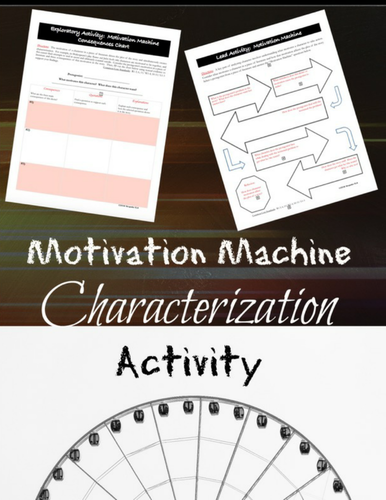
This listing is for a characterization activity entitled "Motivation Machine" in which students analyze how a character's motivations reveal character traits.
This mini-lesson is part of the Mega Characterization Bundle of over 15 characterization mini-lessons that get your students working with all literary devices and techniques. You can find it listed separately in our store.
Bundle and save over $15.00!
For this mini-lesson:
"Motivation Machine"
Task
To analyze the relationship between character motivation and plot
Objectives
To develop criteria for analyzing character
To assess comprehension of character development across a text
To support analysis with textual evidence
Common Core Standards
R1-3, 6, 11/ W1-4, 10-11/ L1-3
Instructions
In this set of activities, students will look at the relationship between character motivation and plot in order to observe how the protagonist’s desires create or drive the plot of the story. The “Motivation Machine” lead activity asks students to consider plot points that are organized according to character decisions. The questions on the “Motivation Machine” Activity follow the typical character motivation pattern as follows:
1. The character has a problem—wants something but cannot get it.
2. The character worsens the problem by making a mistake.
3. The character has to deal with the worsened problem and faces obstacles.
4. The character either solves the problem and gets what he/she wants or does not.
After students complete the “Motivation Machine” activity, they can then complete the three follow-up activities:
“Motivation Machine” Silent Swap
“Motivation Machine” Consequences Chart
“Motivation Machine” Analytical Paragraph
In the Silent Swap, students swap the “Motivation Machine” activity three times and answer reflection questions independently in order to compare/contrast other students’ character analysis with their own. In the “Motivation Machine” Consequences Chart, students consider the cause/ effect relationship of a character’s motivation. In the Analytical Paragraph, students synthesize their findings into a writing task that responds to the question: “How does the protagonist’s motivation affect the plot of the story?” This activity will enable students to grasp how the protagonist creates the action of a story according to what he/she wants.
This mini-lesson is part of the Mega Characterization Bundle of over 15 characterization mini-lessons that get your students working with all literary devices and techniques. You can find it listed separately in our store.
Bundle and save over $15.00!
For this mini-lesson:
"Motivation Machine"
Task
To analyze the relationship between character motivation and plot
Objectives
To develop criteria for analyzing character
To assess comprehension of character development across a text
To support analysis with textual evidence
Common Core Standards
R1-3, 6, 11/ W1-4, 10-11/ L1-3
Instructions
In this set of activities, students will look at the relationship between character motivation and plot in order to observe how the protagonist’s desires create or drive the plot of the story. The “Motivation Machine” lead activity asks students to consider plot points that are organized according to character decisions. The questions on the “Motivation Machine” Activity follow the typical character motivation pattern as follows:
1. The character has a problem—wants something but cannot get it.
2. The character worsens the problem by making a mistake.
3. The character has to deal with the worsened problem and faces obstacles.
4. The character either solves the problem and gets what he/she wants or does not.
After students complete the “Motivation Machine” activity, they can then complete the three follow-up activities:
“Motivation Machine” Silent Swap
“Motivation Machine” Consequences Chart
“Motivation Machine” Analytical Paragraph
In the Silent Swap, students swap the “Motivation Machine” activity three times and answer reflection questions independently in order to compare/contrast other students’ character analysis with their own. In the “Motivation Machine” Consequences Chart, students consider the cause/ effect relationship of a character’s motivation. In the Analytical Paragraph, students synthesize their findings into a writing task that responds to the question: “How does the protagonist’s motivation affect the plot of the story?” This activity will enable students to grasp how the protagonist creates the action of a story according to what he/she wants.
Something went wrong, please try again later.
This resource hasn't been reviewed yet
To ensure quality for our reviews, only customers who have purchased this resource can review it
Report this resourceto let us know if it violates our terms and conditions.
Our customer service team will review your report and will be in touch.
$3.00
